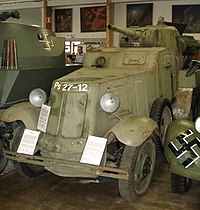| BA-10 | |
|---|---|
 BA-10M armored car, displayed in Finnish Tank Museum, Parola. | |
| Type | Armored car |
| Place of origin | |
| Service history | |
| Used by | |
| Production history | |
| No. built | 3311 |
| Specifications | |
| Mass | 5.14 tonnes (5.67 short tons) |
| Length | 4.65 m (15.3 ft) |
| Width | 2.00 m (6.56 ft) |
| Height | 2.20 m (7.2 ft) |
| Crew | 4 |
| Armor | 6–15 mm |
Main armament | 45 mm gun 20-K (49 rounds) |
Secondary armament | 2× 7.62 DT machine guns (2079 rounds). |
| Engine | GAZ-MM 50 hp (37 kW) |
| Power/weight | 10 hp/tonne |
| Suspension | wheeled |
Operational range | 300 km (190 miles) |
| Maximum speed | 53 km/h (33 mph) |
The BA-10 (Russian: Broneavtomobil 10) was an armored car developed in the Soviet Union in 1938 and produced through 1941. It was the most produced Soviet pre-1941 heavy armored car – 3311 were built in three versions. These versions were the BA-10, the BA-10M (improved version with new radio), and the BA-10ZhD (equipped for dual railway/road use). The basic BA-10 design was developed from the BA-3 and BA-6 heavy armored cars. It had an improved GAZ-AAA chassis and improved armor (up to 15mm at front and turret). It was intended that the BA-10 would be replaced in 1941 by the BA-11 with diesel engine and more sophisticated armor design, but the outbreak of war prevented BA-11 production. The BA-10 was in Red Army service until 1945. Significant numbers of captured BA-10s were used by Finland (at least 24, 3 of which were sold to Sweden[1]), Germany and other Axis powers in Europe.
- ^ Lindström, Rickard. "Pansarbil m/31F". Ointres. Retrieved 12 May 2024.